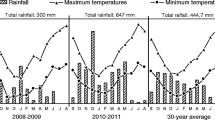Abstract
Potato tubers artificially infected withF. sambucinum were contaminated with diacetoxyscirpenol in concentrations up to 200 μ/tuber. The toxin could also be found in tubers without any disease symptoms. The duration of storage and an increased temperature raised toxin production in infected tubers. Susceptibility of potato cultivars towardsF. sambucinum was well correlated with toxin levels. The concentration of diacetoxyscirpenol in the susceptible cultivar was five times higher compared to the more resistant one. The toxin could not only be found in rotten tuber tissue but also in distant healthy looking parts. There is a gradient in toxin concentrations showing a strong decline with an increasing distance from the infection point. Tissue being 10–15 mm far from the diseased area contained up to 110 μg/kg. Consumers should pay attention to the fact that cutting out the diseased tissue may be not sufficient enough to prevent the intake of mycotoxins.
Similar content being viewed by others
References
Latus-Zietkiewicz D, Perkowski J, Chelkowski J (1995) Mycotoxins production pathogenicity and toxicity ofFusarium species isolated from potato tubers with dry rot injuries. Microbiol. —Alim. —Nutr. 13: 87–100.
Anonymus (2002) German Federal Census Office http://www.destatis.de/jahrbuch/jahrtab21.htm.
Stachewicz H, Lagerfaulen bei Kartoffeln — Bedeutung und Bekämpfung. Kartoffelanbau (1998) 49: 1–3.
Desjardins A E, Plattner R D J (1989) Trichothecene toxin production by strains of Gibberella pulicaris (Fusarium sambucinum) in liquid culture and potato tubers. J. Agric. Food Chem. 37: 388–392.
El-Banna A, Scott P M, Lau P-Y, Sakuma T, Platt H W, Campbell V (1984) Formation of trichothecenes byFusarium solani var. coerulium andFusa- rium sambucinum in potatoes. Appl. Environ. Microbiol. 47(5): 1169–1171.
Jelen H H, Mirocha C J, Wasowicz E, Kaminski E (1995) Production of volatile sesquiterpenes byFusarium sambucinum strains with different abilities to synthesize trichothecenes. Appl. Environ. Microbiol. 61(11): 3815–3820.
Kim Y-C, Lee Y-W (1994) Sambutoxin a new mycotoxin produced by toxicFusarium isolates obtained from rotten potato tubers. Appl. Environ. Microbiol. 60: 4380–4385
Lafont P, Girard T, Payen J, Sarfati J, Gaillardin M (1983) Contamination de pommes de terre de consommation par des fusariotrichothecenes. Micro- biol.-Alim.-Nutr. 1: 147–152.
Author information
Authors and Affiliations
Rights and permissions
About this article
Cite this article
Ellner, F.M. Mycotoxins in potato tubers infected byFusarium sambucinum . Mycotox Res 18, 57–61 (2002). https://doi.org/10.1007/BF02946697
Received:
Accepted:
Issue Date:
DOI: https://doi.org/10.1007/BF02946697




